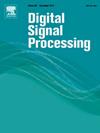A unified estimation method for target number and angle-range parameters in FDA-MIMO radar under impulse noise environments
IF 2.9
3区 工程技术
Q2 ENGINEERING, ELECTRICAL & ELECTRONIC
引用次数: 0
Abstract
In the presence of impulse noise, estimating both the target number and angle-range parameters of frequency diverse array multiple-input multiple-output (FDA-MIMO) radars is a recognized challenge. In this paper, a novel unified method is introduced for simultaneously estimating both the angle-range parameter and target number of FDA-MIMO radars under impulse noise. To mitigate the effects of impulse noise, a novel adaptive low-order covariance (ALC) method that requires no prior information is proposed. Additionally, a two-dimensional spatial spectrum function is derived using the ALC-MVDR method, leveraging the ability of the minimum-variance distortionless response (MVDR) beamformer to provide a two-dimensional spatial spectrum when the target number is unknown. To resolve the two-dimensional spatial spectrum function, the multimodal quantum sunflower optimization algorithm (MQSFOA) is introduced, which can effectively identify the number of spectral peaks and estimate the peak location without quantization errors. The interrelated Cramér–Rao bound (CRB) is then deduced for evaluating the developed method under conditions of impulse noise. Comparative simulation studies demonstrate the significant performance improvements of the presented method.
脉冲噪声环境下FDA-MIMO雷达目标数和角距参数的统一估计方法
在脉冲噪声存在的情况下,分频阵列多输入多输出(FDA-MIMO)雷达的目标数和角距参数估计是一个公认的挑战。提出了一种脉冲噪声下FDA-MIMO雷达角距参数和目标数同时估计的统一方法。为了减轻脉冲噪声的影响,提出了一种不需要先验信息的自适应低阶协方差(ALC)方法。此外,利用最小方差无失真响应(MVDR)波束形成器在目标数未知时提供二维空间频谱的能力,利用ALC-MVDR方法导出二维空间频谱函数。为了求解二维空间光谱函数,引入了多模态量子向日葵优化算法(MQSFOA),该算法可以有效地识别光谱峰的数量并估计峰的位置,且没有量化误差。然后推导出相关的cram r - rao界(CRB),用于在脉冲噪声条件下评价所开发的方法。对比仿真研究表明,该方法的性能得到了显著提高。
本文章由计算机程序翻译,如有差异,请以英文原文为准。
求助全文
约1分钟内获得全文
求助全文
来源期刊

Digital Signal Processing
工程技术-工程:电子与电气
CiteScore
5.30
自引率
17.20%
发文量
435
审稿时长
66 days
期刊介绍:
Digital Signal Processing: A Review Journal is one of the oldest and most established journals in the field of signal processing yet it aims to be the most innovative. The Journal invites top quality research articles at the frontiers of research in all aspects of signal processing. Our objective is to provide a platform for the publication of ground-breaking research in signal processing with both academic and industrial appeal.
The journal has a special emphasis on statistical signal processing methodology such as Bayesian signal processing, and encourages articles on emerging applications of signal processing such as:
• big data• machine learning• internet of things• information security• systems biology and computational biology,• financial time series analysis,• autonomous vehicles,• quantum computing,• neuromorphic engineering,• human-computer interaction and intelligent user interfaces,• environmental signal processing,• geophysical signal processing including seismic signal processing,• chemioinformatics and bioinformatics,• audio, visual and performance arts,• disaster management and prevention,• renewable energy,
 求助内容:
求助内容: 应助结果提醒方式:
应助结果提醒方式:


